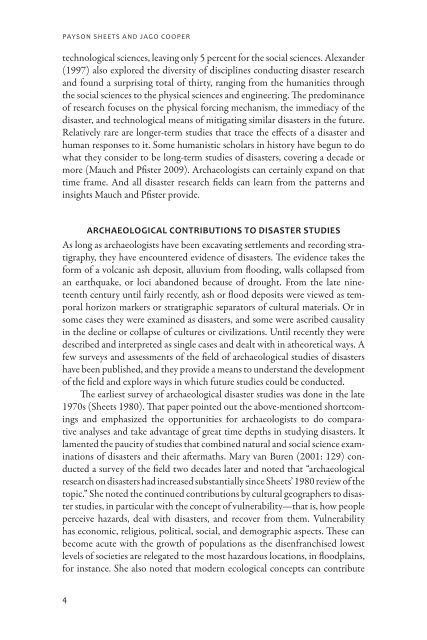free download - University Press of Colorado
free download - University Press of Colorado
free download - University Press of Colorado
Create successful ePaper yourself
Turn your PDF publications into a flip-book with our unique Google optimized e-Paper software.
Payson Sheets and Jago Cooper<br />
technological sciences, leaving only 5 percent for the social sciences. Alexander<br />
(1997) also explored the diversity <strong>of</strong> disciplines conducting disaster research<br />
and found a surprising total <strong>of</strong> thirty, ranging from the humanities through<br />
the social sciences to the physical sciences and engineering. The predominance<br />
<strong>of</strong> research focuses on the physical forcing mechanism, the immediacy <strong>of</strong> the<br />
disaster, and technological means <strong>of</strong> mitigating similar disasters in the future.<br />
Relatively rare are longer-term studies that trace the effects <strong>of</strong> a disaster and<br />
human responses to it. Some humanistic scholars in history have begun to do<br />
what they consider to be long-term studies <strong>of</strong> disasters, covering a decade or<br />
more (Mauch and Pfister 2009). Archaeologists can certainly expand on that<br />
time frame. And all disaster research fields can learn from the patterns and<br />
insights Mauch and Pfister provide.<br />
Archaeological Contributions to Disaster Studies<br />
As long as archaeologists have been excavating settlements and recording stratigraphy,<br />
they have encountered evidence <strong>of</strong> disasters. The evidence takes the<br />
form <strong>of</strong> a volcanic ash deposit, alluvium from flooding, walls collapsed from<br />
an earthquake, or loci abandoned because <strong>of</strong> drought. From the late nineteenth<br />
century until fairly recently, ash or flood deposits were viewed as temporal<br />
horizon markers or stratigraphic separators <strong>of</strong> cultural materials. Or in<br />
some cases they were examined as disasters, and some were ascribed causality<br />
in the decline or collapse <strong>of</strong> cultures or civilizations. Until recently they were<br />
described and interpreted as single cases and dealt with in atheoretical ways. A<br />
few surveys and assessments <strong>of</strong> the field <strong>of</strong> archaeological studies <strong>of</strong> disasters<br />
have been published, and they provide a means to understand the development<br />
<strong>of</strong> the field and explore ways in which future studies could be conducted.<br />
The earliest survey <strong>of</strong> archaeological disaster studies was done in the late<br />
1970s (Sheets 1980). That paper pointed out the above-mentioned short comings<br />
and emphasized the opportunities for archaeologists to do comparative<br />
analyses and take advantage <strong>of</strong> great time depths in studying disasters. It<br />
lamented the paucity <strong>of</strong> studies that combined natural and social science examinations<br />
<strong>of</strong> disasters and their aftermaths. Mary van Buren (2001: 129) conducted<br />
a survey <strong>of</strong> the field two decades later and noted that “archaeological<br />
research on disasters had increased substantially since Sheets’ 1980 review <strong>of</strong> the<br />
topic.” She noted the continued contributions by cultural geographers to disaster<br />
studies, in particular with the concept <strong>of</strong> vulnerability—that is, how people<br />
perceive hazards, deal with disasters, and recover from them. Vulnerability<br />
has economic, religious, political, social, and demographic aspects. These can<br />
become acute with the growth <strong>of</strong> populations as the disenfranchised lowest<br />
levels <strong>of</strong> societies are relegated to the most hazardous locations, in floodplains,<br />
for instance. She also noted that modern ecological concepts can contribute<br />
4





